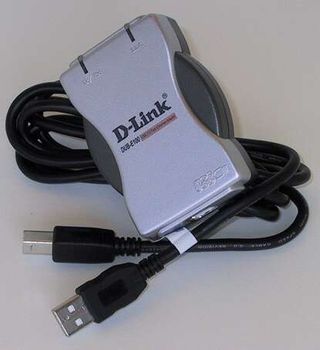USB 2.0: High-Speed Devices from D-Link
DUB-E100: Introduction

D-Link also provides a much-needed USB 2.0 device, a 10/100 Mbps fast Ethernet adapter. The D-Link DUB-E100 supports NWAY Auto-Negotiation to achieve the highest performance level. It is hot-swappable, plug and play compliant, and bus-powered. The E100 is all you need to get your computer connected to a network.
Definition of NWay Auto-Negotiation: National Semiconductor introduced a technology called NWay Auto-Negotiation in Spring 1994. The development of NWay was prompted due to the need to accommodate multi-speed network devices. NWay is the mechanism that takes control when you attach your network card to a hub, switch or another network card. It sends its capabilities to the other end of the wire and automatically adjusts to the highest performance mode that the device on the other end of the wire can support.
The DUB-E100 eliminates the need to use another network card in your computer. Unlike ISA and PCI network cards, you will not have to open your computer's case to install the DUB-E100. There is no external power supply required for this bus-powered device. It supports the USB standard's 'suspend' and 'resume,' in order to reduce power consumption.
Package Contents And Connectors/ Indicators
The DUB-E100 package contains the DUB-E100 USB 2.0 fast Ethernet adapter, a six-foot USB 2.0 cable, an Installation Guide, a CD-ROM that contains the necessary drivers for Windows 98, 98SE, Me, 2000, XP and a typical warranty card.
There are two indicators and two connectors on the DUB-E100. There is a link indicator and a Tx/Rx (transmitting and receiving) indicator. The link indicator is a dual-colored LED that illuminates amber when the unit is operating at 10 Mbps and green when the unit is operating at 100 Mbps. The Tx/Rx indicator will flash green when the unit is transmitting or receiving data. The connectors consist of a Type B USB connector and a standard RJ-45 connector. The Type B connector is used to connect the DUB-E100 to your computer, and the RJ-45 connector is used to connect your device to your network.
Stay on the Cutting Edge
Join the experts who read Tom's Hardware for the inside track on enthusiast PC tech news — and have for over 25 years. We'll send breaking news and in-depth reviews of CPUs, GPUs, AI, maker hardware and more straight to your inbox.
Most Popular

